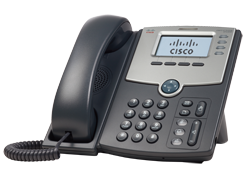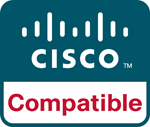Cisco Solutions
As a Solutions Developer Partner with the CDN (Cisco Developer Network), we provide a fully integrated call recording and live monitoring solution that is certified fully “Cisco Compatible”. The Edigin solution supports both traditional span based recording and automatic recording via BIB (built in bridge).

Our solution is integrated with the Cisco TAPI interface to provide silent call monitoring and recording on demand. Automatic recording and application invoked recording are supported.
Automatic recording and application invoked recording are integrated with CUCM in versions 7.x, 8.x, 9.x, 10.x, 11.x and 12.x. In automatic recording, the recording session automatically establishes when an agent answers or initiates a call. In application invoked recording, the application invokes the recording session for an active call through TAPI.
 Integration
Integration
For more information about the Edigin SVRX integration with Cisco, or any other integration platform we support, please contact the sales department using the form provided, email us directly, or call.
 Recording Using Unified Communications Manager
Recording Using Unified Communications Manager
Cisco Unified Communications Manager (CUCM) provides two recording modes:
- Automatic Recording: All calls are recorded on a line appearance and recording is invoked by CUCM
- Selective Recording: The supervisor, agent and/or recording server can record temporarily
When a recording session is invoked, automatically or selectively, CUCM delivers two RTP streams to our recording server through a session initiation protocol (SIP) trunk. We mix the stream into a single recorded call and also receive TAPI events on the call to capture specific call details. This includes information such as calling and called party numbers.
- Silent recording has no perceptible effect on the agent’s or customer’s visual display
- There is no perceptible audio glitch that might alert the agent or the customer that their call is being recorded
- Supported by all 3rd generation phones
- 7906G, 7911G, 7931G, 7941G, 7941G-GE, 7961G, 7961G-GE, 7970G, and 7971G-GE
- 88xx
- Does not require SPAN
- Is network topology-friendly
- Supports CAC, bandwidth reservation, and codec negotiation
- Can provide notification tones when legal compliance is required
The SVRX supports recording on demand using application-invoked recording and the TAPI interface. There are three separate methods of initiating a recording:
- Phone: IP phone services from the phone
- Web: The SVRX web based monitoring dashboard
- Application: An installed SVRX client application
Recording on demand also supports two modes of recording:
- Toggle mode: Allows the recorder to be turned on or off at any time<.li>
- Entire call mode: Records the entire call no matter when in the call the record request was made
 Malicious Call Recording
Malicious Call Recording
Many installations require the protection of on demand recording of threatening or malicious calls. The Edigin SVRX is seamlessly integrated with the Cisco malicious call identification (MCID) softkey on the phone. If at any time during a call the MCID key is pressed, the entire call will be recorded regardless of the point in the call the key was pressed.
- Recording is triggered automatically when MCID key is pushed
- The MCID key can be pushed at any time during the call
- The entire call, including the portion before the key is pushed is recorded
- Easy search and playback of threatening calls via a browser based user interface
 Remote Employee Recording
Remote Employee Recording
Many companies are taking advantage of work from home employees, but this does not eliminate the requirement to record their phone calls. There are significant challenges associated with recording remote employee phones calls since most recording applications rely on spanning the traffic from the network device the phone is connected to. The Edigin SVRX solves this problem and provides a centralized recording solution for all remote employee phones.
- Provides centralized recording of remote employee phones
- Available for phones operating on a company VPN
- Available for phones operating through a Session Border Controller over the Internet
 Silent Monitoring Using CUCM
Silent Monitoring Using CUCM
Real-time monitoring allows supervisors or authorized users to listen to live calls for the purpose of quality assurance and training. CUCM silent monitoring is invoked by a supervisor through an application using TAPI. When a monitoring session begins, the supervisor device goes off-hook and makes a special call to the agent device. This call is answered automatically and silently. The BIB in the agent’s phone mixes the customer and agent streams together to form a single, combined RTP stream, that is delivered to the supervisor under Unified Communications Manager control.
- Silent monitoring has no perceptible effect on the agent’s or customer’s visual display
- There is no perceptible audio artifact that might alert the agent or customer that their call is being observed
- CAC, bandwidth reservation, and codec negotiation rules are automatically applied to the monitored call
- Security restriction on which phones can be monitored on a per user basis
- Allows supervisors to monitor agents through a Cisco Unified IP phone
- Allows monitored calls to be managed like normal calls (for example: held or added to a conference)
- Does not require SPAN
- Network topology-friendly
- Provides notification tones when legal compliance is required
- Can be activated with IP Phone services
- Can be activated with the web based monitoring dashboard
 IP Recording for VG224 and VG248
IP Recording for VG224 and VG248
The Cisco VG224 and VG248 are analog voice gateways for either 24 or 48 analog extensions and, until now, those analog extensions would have to be individually tapped to get them each recorded. The SVRX patent pending ALGR VoIP recording technology allows recording of all analog extensions via a single network monitor session from the voice gateway. This eliminates the traditional analog wiring required to record those extensions.
- No analog wiring or recording is required
- IP traffic in/out of the VG is directed into the recorder
- Patent pending ALGR IP technology individually associates recordings with the proper analog extension


 Fill out the form below to be contacted by one of our sales agents.
Fill out the form below to be contacted by one of our sales agents.